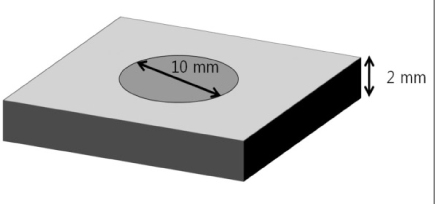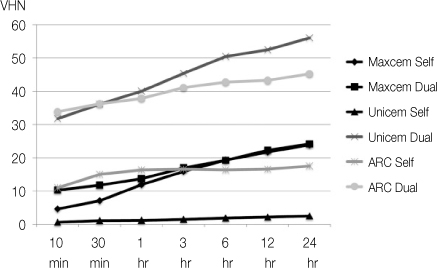J Korean Acad Conserv Dent.
2011 Mar;36(2):132-138. 10.5395/JKACD.2011.36.2.132.
Effect of curing modes on micro-hardness of dual-cure resin cements
- Affiliations
-
- 1Department of Conservative Dentistry, Gangneung-Wonju National University College of Dentistry, Gangneung, Korea. drbozon@gwnu.ac.kr
- KMID: 2251818
- DOI: http://doi.org/10.5395/JKACD.2011.36.2.132
Abstract
OBJECTIVES
The purpose of this study was to evaluate curing degree of three dual-cure resin cements with the elapsed time in self-cure and dual-cure mode by means of the repeated measure of micro-hardness.
MATERIALS AND METHODS
Two dual-cure self-adhesive resin cements studied were Maxcem Elite (Kerr), Rely-X Unicem (3M ESPE) and one conventional dual-cure resin cement was Rely-X ARC resin cement (3M ESPE). Twenty specimens for each cements were made in Teflon mould and divided equally by self-cure and dual-cure mode and left in dark, 36degrees C, 100% relative humidity conditional-micro-hardness was measured at 10 min, 30 min, 1 hr, 3 hr, 6 hr, 12 hr and 24 hr after baseline. The results of micro-hardness value were statistically analyzed using independent samples t-test and one-way ANOVA with multiple comparisons using Scheffe's test.
RESULTS
The micro-hardness values were increased with time in every test groups. Dual-cure mode obtained higher micro-hardness value than self-cure mode except after one hour of Maxcem. Self-cured Rely-X Unicem showed lowest value and dual-cured Rely-X Unicem showed highest value in every measuring time.
CONCLUSIONS
Sufficient light curing to dual-cure resin cements should provided for achieve maximum curing.
Keyword
Figure
Reference
-
1. Theodore M, Harald O, Edward J. Sturdevant's art & science of operative dentistry. 2006. 5th ed. St. Louis, USA: Mosby;225–227.2. Mitchell CA, Abbariki M, Orr JF. The influence of luting cement on the probabilities of survival and modes of failure of cast full-coverage crowns. Dent Mater. 2000. 16:198–206.
Article3. Kwon PC, Park JW. Influence of thickness on the degree of cure of composite resin core material. J Korean Acad Conserv Dent. 2006. 31:352–358.
Article4. Kim YJ, Jin MU, Kim SK, Kwon TY, Kim YK. Polymerization of dual cured composites by different thickness. J Korean Acad Conserv Dent. 2008. 33:169–176.
Article5. Cadenaro M, Navarra CO, Antoniolli F, Mazzoni A, Di Lenarda R, Rueggeberg FA, Breschi L. The effect of curing mode on extent of polymerization and microhardness of dual-cured, self-adhesive resin cements. Am J Dent. 2010. 23:14–18.6. Borges GA, Agarwal P, Miranzi BA, Platt JA, Valentino TA, dos Santos PH. Influence of different ceramics on resin cement Knoop Hardness Number. Oper Dent. 2008. 33:622–628.
Article7. Shin HJ, Song CK, Park SH, Kim JW, Cho KM. Physical properties of different self-adhesive resin cements and their shear bond strength on lithium disillicate ceramic and dentin. J Korean Acad Conserv Dent. 2009. 34:184–191.
Article8. Danesh G, Davids H, Reinhardt KJ, Ott K, Schäfer E. Polymerisation characteristics of resin composites polymerised with different curing units. J Dent. 2004. 32:479–488.
Article9. Ferracane JL. Hygroscopic and hydrolytic effects in dental polymer networks. Dent Mater. 2006. 22:211–222.
Article10. Noronha Filho JD, Brandäo NL, Poskus LT, Guimaräes JG, Silva EM. A critical analysis of the degree of conversion of resin-based luting cements. J Appl Oral Sci. 2010. 18:442–446.
Article11. Pedreira AP, Pegoraro LF, Góes MF, Pegoraro TA, Carvalho RM. Microhardness of reisn cements in the intraradicular environment: effect of water storage and softening treatment. Dent Mater. 2009. 25:868–876.
Article12. Vrochari AD, Eliades G, Hellwig E, Wrbas KT. Curing efficiency of four self-etching, self-adhesive resin cements. Dent Mater. 2009. 25:1104–1108.
Article13. Rueggeberg FA, Craig RG. Correlation of parameters used to estimate monomer conversion in light-cured composite. J Dent Res. 1988. 67:932–937.
Article14. Ferracane JL. Correlation between hardness and degree of conversion during the setting reaction of unfilled dental restorative resins. Dent Mater. 1985. 1:11–14.
Article15. Mazzitelli C, Monticelli F, Osorio R, Casucci A, Toledano M, Ferrari M. Effect of simulated pulpal pressure on self-adhesive cements bonding to dentin. Dent Mater. 2008. 24:1156–1163.
Article16. Tezvergil-Mutluay A, Lassila LV, Vallittu PK. Degree of conversion of dual-cure luting resins light-polymerized through various materials. Acta Odontol Scand. 2007. 65:201–205.
Article17. Monteiro GQ, Souza FB, Pedrosa RF, Sales GC, Castro CM, Fraga SN, Galväo BH, Braz R. In vitro biological responsetoa self-adhesive resin cement under different curing strategies. J Biomed mater Res B Appl Biomater. 2010. 92:317–321.18. Piwowarczyk A, Bender R, Ottl P, Lauer HC. Long-term bond between dual-polymerizing cementing agents and human hard dental tissue. Dent Mater. 2007. 23:211–217.
Article19. Aguiar TR, Di Francescantonio M, Ambrosano GMB, Gianini M. Effect of curing mode on bond strength of self-adhesive resin luting cements to dentin. J Biomed mater Res B Appl Biomater. 2010. 93:122–127.
Article20. Roberts HW, Leonard DL, Vandewalle KS, Cohen ME, Charlton DG. The effect of a translucent post on resin composite depth of cure. Dent Mater. 2004. 20:617–622.
Article
- Full Text Links
- Actions
-
Cited
- CITED
-
- Close
- Share
- Similar articles
-
- Evaluation of mechanical properties of several dual-cure resin cements by curing modes
- Light curing of dual cure resin cement
- Microhardness of resin cements after light activation through various translucencies of monolithic zirconia
- Comparison of polymerization shrinkage of dual-cure core build-up resin according to shade and curing mode
- Effects of immediate and delayed light activation on the polymerization shrinkage-strain of dual-cure resin cements



